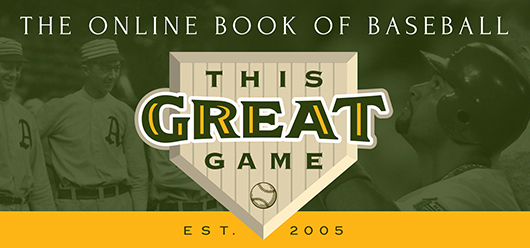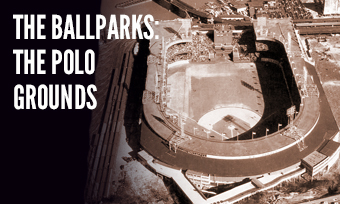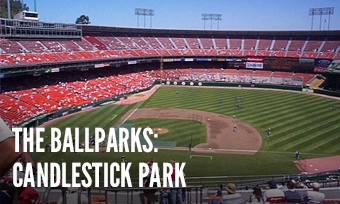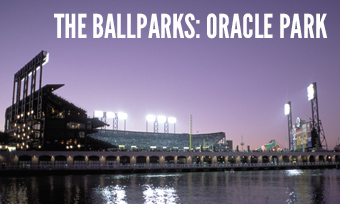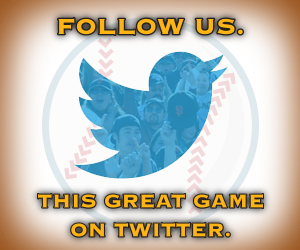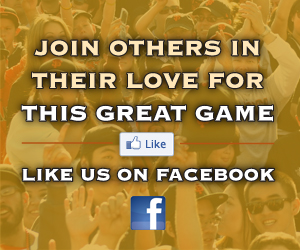THE TEAMS
San Francisco Giants
Known as the New York Gothams, 1883-84; New York Giants, 1885-57
THE GIANTS BY THE DECADE
The 19th Century
Created from the ashes of two failed National League teams, the Giants were initially set up in 1883 as part of two-team startup by John B. Day and Jim Mutrie, who also put together a team in the inferior American Association and had both play at adjacent fields. The AA team would fold after four seasons, while the Giants—named as such after owner-manager Mutrie excitedly referred to his players as “My Giants”—created a strong foothold with consecutive pennants in 1888-89 behind 19th Century slugger Roger Connor (baseball’s all-time home run leader until Babe Ruth) and workhorse pitching from Mickey Welch and Tim Keefe. Under financial duress, the Giants were sold in 1895 to Tammany Hall bigwig Andrew Freedman; under his detestable rule, the team descended into an ongoing soap opera worthy of George Steinbrenner, minus the championship glory.
The 1900s
After attempting to sabotage the American League’s Baltimore Orioles, fiery, diminutive manager John McGraw partnered with former Cincinnati owner John Brush to rescue the Giants from Freedman in 1902. Almost overnight, the team improved into a scrappy perennial contender led by the incomparable pitching duo of Christy Mathewson and Joe McGinnity, who efficiently ate up both innings and opponents. Their combined talents hit a high note at the 1905 World Series when they pitched 44 of 45 innings in a five-game triumph over the Philadelphia A’s—and didn’t allow a single earned run.
The 1910s
The Giants remained the National League’s marquee franchise, winning four pennants—but losing each time at the World Series, often in disheartening fashion. McGinnity was gone and Mathewson was fading, but McGraw replenished his corps with one solid roster after another that featured no superstars—and no weaknesses. Support for the team remained loyal at the Polo Grounds, which burned to the ground shortly after the start to the 1911 season—to be quickly replaced by a steel-and-concrete version of the stadium that would last into the 1960s.
The 1920s
Fueled with an infusion of potent, highly talented hitters led by Ross Youngs, Frankie Frisch and George Kelly, the Giants dominated the early portion of the decade with four straight NL flags—winning two “Subway Series” in 1921-22 over the local rival Yankees, whom McGraw came to abhor with a touch of jealousy towards star bopper Babe Ruth. The Giants remained competitive in late decade but failed to reach the top despite brief stints from star sluggers Hack Wilson and Rogers Hornsby.
The 1930s
Aging and losing energy, McGraw stepped down in 1932 and gave the managerial reins to Bill Terry, the last NL player to hit .400 in 1930—the same year the Giants set an all-time mark with a .319 team average. As manager, Terry retained the winning ethic, taking three NL pennants over a five-year period and a world title in his first full year, over Washington in 1933. On the field, the Giants were unquestionably led by screwball ace Carl Hubbell and slugger Mel Ott, who led the Giants in home runs every year between 1928-45.
The 1940s
Like most teams during World War II, the Giants’ fortunes were dictated by what talent was available as many players went into military service; per example, the third-place showing of the 1942 team was followed up by 98 losses one season later. The immediate postwar years brought stability back to the Polo Grounds, but not much triumph as the Giants experienced their first pennantless decade of the century. Ott finished his career as the first NL player with 500 home runs, and the 1947 Giants became the first major league team to bash 200.
The 1950s
Dynamic new talent led by peerless outfielder Willie Mays gave the Giants an early-decade resurgence and two NL titles, both highlighted by legendary moments: Bobby Thomson’s “Shot Heard ‘Round the World” homer than capped an unlikely late-season comeback over Brooklyn in 1951, and Mays’ over-the-shoulder catch in the team’s sweep of Cleveland in the 1954 World Series. But the neighborhood alarmingly decayed around the aging Polo Grounds and owner Horace Stoneham wanted out; following the lead of the Dodgers, he moved the Giants to California, setting up shop in San Francisco starting in 1958.
The 1960s
With Mays at peak form, the emergence of numerous young, future Hall of Famers (Willie McCovey, Orlando Cepeda, Juan Marichal and Gaylord Perry) and the opening of modern (but often Arctic) Candlestick Park, the Giants looked set for a fabulous decade—yet they found themselves frequently logging second- and third-place finishes, winning the NL only once in 1962 after ousting the Dodgers in a three-game playoff, as they did in 1951; they fell short to the Yankees in a heartbreaking seven-game World Series.
The 1970s
The Giants’ aging stars were traded or released in a series of horrendous moves that signaled the beginning of the end of the Stoneham era; local competition from the flashy, champion A’s in Oakland and a multi-purpose expansion of Candlestick (which briefly included a rock-hard artificial surface) only made matters worse, as attendance shrank to next to nothing. Bob Lurie purchased the Giants in 1976 and saved the franchise from a move out of town; under his early watch, real grass and bigger crowds (if not success on the field) returned to Candlestick as the team began spending money again.
The 1980s
After a shaky start to the decade, the Giants hit onto a long-overdue period of sustained winning when manager Roger Craig took the reins and taught his core of youthful talent (led by brash slugger Will Clark) to embrace Candlestick’s chilly environment. The results were infectious; the Giants came within one game of a NL pennant in 1987 and then conquered the circuit in 1989, before being flattened by the A’s in a ‘Bay Bridge’ Series painfully overshadowed by a 6.9 earthquake before Game Three that nearly cancelled the whole event.
The 1990s
Fed up with Candlestick and unable to get a new ballpark built locally, Lurie sold the Giants to St. Petersburg investors who planned to move the team to Florida—but baseball nixed the deal in favor of a less expensive offer fronted by Peter Magowan, who kept the team in San Francisco, embraced the team’s storied past and brought in Barry Bonds, who continually improved and tightened his grip on the title of the game’s greatest active player. Under Magowan and Bonds, the Giants won 103 games in 1993 but, a year before the advent of the wild card, lost a shot at the playoffs by one game, before securing a NL West title in 1997.
The 2000s
The new century began with the Giants moving from one of the game’s most reviled ballparks to one of the most beautiful at Pac Bell (now Oracle) Park, located closer to downtown and complete with bay waters behind right field. Reaching into his late 30s, Bonds was expected to decline—but instead evolved from superstar to superhuman, breaking season and career home run records with startling ease (while nearly giving the Giants a championship in 2002); it was later revealed that his late career spurt was the result of steroid use. Bonds’ departure in 2007 set the tone for a wholly different Giants team structure focused on rock solid pitching.
The 2010s
The call-to-arms philosophy paid off in 2010 as rotation stars Tim Lincecum, Matt Cain and rookie Madison Bumgarner delivered the franchise’s first world title since moving to San Francisco 52 years earlier; they won another just two seasons later with help at the plate from MVP catcher Buster Posey, and two more years after that did it once more with an astonishing postseason effort from the imposing Bumgarner. But despite the best efforts by popular manager Bruce Bochy to maintain the championship aura, the Giants struggled in the decade’s latter half to adapt to baseball’s power surge as an aging, offensive-challenged roster failed to deliver.
The 2020s
Change came both to the front office (with highly-respected Farhan Zaidi assuming player moves) and the dugout as a retired Bochy gave way to Gabe Kapler, who maximized a modestly-talented roster through an aggressive platooning strategy. That tactic paid off in spades in 2021, when the Giants stunningly spiked with a franchise-record 107 wins, before conceding a tough first-round playoff defeat to the archrival Dodgers.
Highlights of the Giants’ History on This Great Game:
 1904: McGraw v. Johnson The World Series becomes a casualty of a continued feud between two of the games’s most powerful men.
1904: McGraw v. Johnson The World Series becomes a casualty of a continued feud between two of the games’s most powerful men.
 1905: The Zero Heroes The Giants’ Christy Mathewson and Joe McGinnity completely deny the Philadelphia Athletics in the World Series.
1905: The Zero Heroes The Giants’ Christy Mathewson and Joe McGinnity completely deny the Philadelphia Athletics in the World Series.
 1908: The Merkle Boner A 19-year-old rookie costs the Giants by committing one of the game’s most notorious blunders.
1908: The Merkle Boner A 19-year-old rookie costs the Giants by committing one of the game’s most notorious blunders.
 1913: Giant Bridesmaids, Again Not even good luck charm Charlie Faust can save the Giants from another World Series defeat.
1913: Giant Bridesmaids, Again Not even good luck charm Charlie Faust can save the Giants from another World Series defeat.
 1921: See You at the Polo Grounds The home for both the New York Yankees and Giants becomes the exclusive host to the first Subway Series.
1921: See You at the Polo Grounds The home for both the New York Yankees and Giants becomes the exclusive host to the first Subway Series.
 1933: Making Little Napoleon Proud An ailing John McGraw hands the managerial reins to first baseman Bill Terry—who promptly rides the Giants back to triumph.
1933: Making Little Napoleon Proud An ailing John McGraw hands the managerial reins to first baseman Bill Terry—who promptly rides the Giants back to triumph.
 1951: The Shot Heard ’Round the World Bobby Thomson’s historic home run caps one of baseball’s greatest pennant races for the Giants.
1951: The Shot Heard ’Round the World Bobby Thomson’s historic home run caps one of baseball’s greatest pennant races for the Giants.
 1954: At Least They Stopped the Yanks The Cleveland Indians go into juggernaut mode and upend the perennial AL favorite Yankees with 111 wins—but their momentum is stopped cold by the Giants in October.
1954: At Least They Stopped the Yanks The Cleveland Indians go into juggernaut mode and upend the perennial AL favorite Yankees with 111 wins—but their momentum is stopped cold by the Giants in October.
 1958: And Now, From Coast to Coast The Giants and Dodgers break the hearts of New Yorkers everywhere and head west to California.
1958: And Now, From Coast to Coast The Giants and Dodgers break the hearts of New Yorkers everywhere and head west to California.
 1962: Lined to Second Best After an exhilirating pennant race, the Giants lose a seven-game World Series when Willie McCovey’s potential series-winning hit is snared out of the air by Yankee second baseman Bobby Richardson.
1962: Lined to Second Best After an exhilirating pennant race, the Giants lose a seven-game World Series when Willie McCovey’s potential series-winning hit is snared out of the air by Yankee second baseman Bobby Richardson.
 1989: Of Triumph and Tragedy The Giants figure prominently in a rough year for the game, with Dave Dravecky’s triumphant comeback bid stopped cold and a World Series date with the cross-bay Oakland A’s shaken up by a major earthquake before Game Three.
1989: Of Triumph and Tragedy The Giants figure prominently in a rough year for the game, with Dave Dravecky’s triumphant comeback bid stopped cold and a World Series date with the cross-bay Oakland A’s shaken up by a major earthquake before Game Three.
 2002: The Wild, Wild Card West The red-hot Anaheim Angels—riding high on the back of their Rally Monkey—attempt to overcome Barry Bonds and the Giants.
2002: The Wild, Wild Card West The red-hot Anaheim Angels—riding high on the back of their Rally Monkey—attempt to overcome Barry Bonds and the Giants.
 2007: Bow if You Will, Spit if You Wish Barry Bonds breaks Hank Aaron’s fabled career home run mark, but few people are happy about it.
2007: Bow if You Will, Spit if You Wish Barry Bonds breaks Hank Aaron’s fabled career home run mark, but few people are happy about it.
 2010: Joy and Torture Combining excellent pitching and edge-of-your-seat thrills, the Giants finally win it all.
2010: Joy and Torture Combining excellent pitching and edge-of-your-seat thrills, the Giants finally win it all.
 2012: A Giant October Surprise The Giants make it two world titles in three years after surviving a season full of injuries, challenges and handicaps.
2012: A Giant October Surprise The Giants make it two world titles in three years after surviving a season full of injuries, challenges and handicaps.

